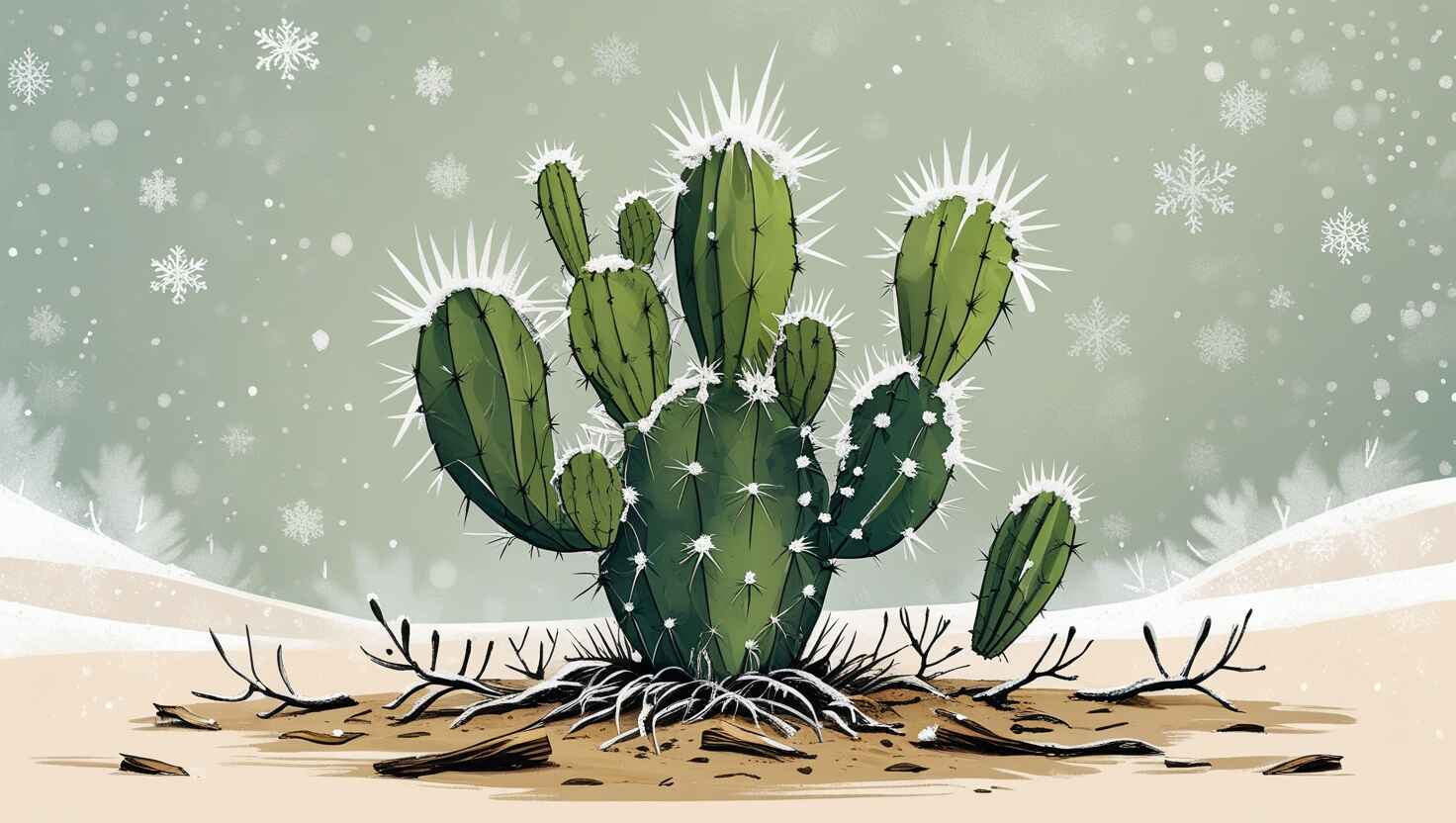Prickly pear cacti (Opuntia spp.) are beloved for their distinctively flat, paddle-like pads, vibrant flowers, and resilience in arid climates. But when winter rolls in, even these hardy plants need a bit of help to weather the cold. This comprehensive guide will walk you through everything you need to know to keep your prickly pear cactus healthy during winter, whether you’re growing it outdoors in a garden or indoors in a pot.
Why Winter Care Matters for Prickly Pear Cactus
Though prickly pear cacti are native to desert and semi-arid regions, many species can tolerate cold weather with proper preparation. However, neglecting their winter needs can lead to frost damage, root rot, or even death. Proper winter care ensures your cactus not only survives but thrives when the growing season returns.
Understanding the Prickly Pear Cactus
- Species Overview: Prickly pear cacti are part of the Opuntia genus, which includes over 180 species. Some, like the Eastern prickly pear (Opuntia humifusa), are remarkably cold-hardy, tolerating temperatures as low as -20°F (-29°C). Others, like Opuntia ficus-indica, prefer warmer climates and need more protection in winter.
- Unique Features: These cacti feature flat pads (cladodes) that store water, spines for protection, and vibrant flowers that bloom in spring or summer. The pads and fruits (called “tunas”) are edible, making them a practical and attractive addition to any garden.
How Cold is Too Cold for a Prickly Pear Cactus?
Most prickly pear species are hardy in USDA zones 7–10. However, cold-hardiness depends on the specific species:
- Cold-Hardy Species: Eastern prickly pear (Opuntia humifusa), Opuntia polyacantha, and Opuntia macrorhiza can handle freezing temperatures.
- Sensitive Species: Mexican prickly pear (Opuntia ficus-indica) and other tropical species need extra protection when temperatures drop below 32°F (0°C).
Understanding your cactus’s cold tolerance will help you determine the level of care required during winter.
Preparing Your Prickly Pear Cactus for Winter
1. Outdoor Cacti in Ground
If your cactus is planted in the ground, take the following steps to prepare it for winter:
- Reduce Watering: In late fall, start reducing how often you water. Overwatering during dormancy can cause root rot, especially in cold weather. Allow the soil to dry completely between waterings.
- Stop Fertilizing: Fertilizer encourages growth, which is more vulnerable to frost damage. Cease fertilization by late summer.
- Apply Mulch: Spread a 2–3 inch layer of dry mulch (straw, pine needles, or wood chips) around the base of your cactus. This insulates the roots from temperature fluctuations.
- Cover for Frost: Use frost cloth, burlap, or blankets to shield your cactus during freezing nights. Avoid letting the material touch the cactus directly to prevent damage.
2. Potted Cacti
Potted prickly pear cacti are easier to protect during winter:
- Move Indoors: Bring your cactus inside before the first frost. Place it in a sunny spot, such as a south-facing window.
- Adjust Watering: Water sparingly during winter dormancy—about once every 4–6 weeks or when the soil is completely dry.
- Temperature Control: Keep indoor temperatures between 50–65°F (10–18°C) to replicate natural winter conditions.
Protecting Prickly Pear Cactus from Frost Damage
Frost is one of the biggest threats to prickly pear cacti during winter. Here are some additional tips to minimize frost damage:
- Elevate the Plant: If the cactus is in a pot, place it on a stand or shelf to keep it off cold floors or patios.
- Use Heat Sources: For outdoor cacti, stringing outdoor-safe Christmas lights around the cactus can provide gentle warmth during frosty nights.
- Wind Barriers: Set up a windbreak using wooden boards or burlap screens to shield the cactus from icy winds.
Indoor Care for Prickly Pear Cactus During Winter
Bringing your cactus indoors is an excellent way to shield it from harsh weather. Here’s how to care for it:
- Lighting: Place the cactus in a spot with plenty of natural light. If sunlight is limited, use grow lights to provide 6–8 hours of light daily.
- Humidity: Maintain low humidity levels to mimic desert conditions. Avoid placing the cactus near humidifiers or water sources.
- Check for Pests: Indoor cacti can attract pests like spider mites or mealybugs. Inspect regularly and treat infestations with neem oil or insecticidal soap.
Post-Winter Transition: Getting Your Cactus Ready for Spring
As winter ends, it’s important to ease your cactus back into its active growth phase:
- Gradual Sunlight Exposure: If your cactus was indoors, start by placing it outside in partial shade for a few hours each day. Gradually increase sunlight exposure over 1–2 weeks.
- Increase Watering: Resume regular watering as temperatures rise, but don’t overdo it. Always check that the soil is dry before watering.
- Resume Fertilizing: Feed your cactus with a balanced, low-nitrogen fertilizer to encourage healthy growth and blooming.
Common Winter Challenges for Prickly Pear Cactus
- Root Rot
- Cause: Overwatering or poorly draining soil.
- Solution: Use a well-draining cactus mix and water sparingly in winter.
- Pest Infestations
- Common Pests: Spider mites, mealybugs, and scale insects.
- Prevention: Inspect your cactus regularly and treat with neem oil or insecticidal soap as needed.
- Frost Damage
- Signs: Blackened or mushy pads.
- Prevention: Cover the cactus during frosty nights and avoid overwatering.
FAQs on Prickly Pear Cactus Winter Care
1. Can all prickly pear cacti survive freezing temperatures?
Not all species are cold-hardy. Research your specific cactus species to understand its cold tolerance.
2. Should I water my cactus in winter?
Water sparingly during winter dormancy, about once every 4–6 weeks, or only when the soil is completely dry.
3. How do I protect my outdoor cactus from snow?
Cover the cactus with frost cloth or burlap and ensure the soil drains well to prevent root rot.
4. Can I leave my cactus outside in winter?
If you live in USDA zones 7–10 and have a cold-hardy species, your cactus can stay outside with proper protection.
5. What should I do if my cactus gets frost damage?
Remove the damaged pads and adjust care practices to prevent further harm. Ensure it receives adequate sunlight and avoid overwatering.
The Benefits of Winter Care for Prickly Pear Cacti
Providing proper winter care ensures that your prickly pear cactus:
- Remains healthy and vibrant.
- Produces more flowers and fruits in the growing season.
- Lives longer and resists pests and diseases.
With the right preparation, your cactus will thrive even in the harshest winters, ready to bring beauty and utility to your garden when spring returns.
Conclusion
Caring for a prickly pear cactus during winter might seem daunting at first, but with the right knowledge and preparation, it’s entirely manageable. Whether your cactus is planted outdoors or kept in a pot, the key lies in understanding its needs and tailoring your care accordingly. From reducing watering to providing frost protection, these steps will help your prickly pear survive and thrive through the cold season. Start preparing today, and you’ll be rewarded with a healthy, happy cactus come spring!

